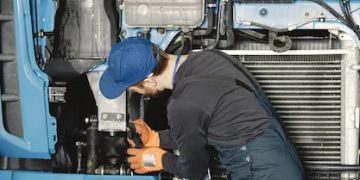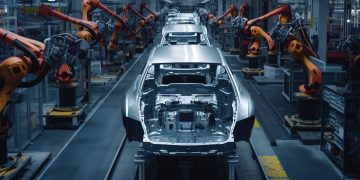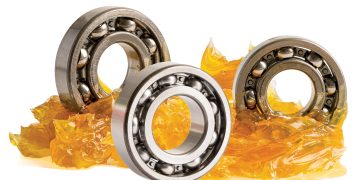The Automotive Industry is fast forwarding towards an admiringly advanced, digitally able, safely handled and proteanly productive future. This is evident in all walks of the industry. Nuanced and fundamental progress is happening in the base too. The advancement in vehicle lifts are notable in this regard.
Advanced vehicle lifts not only lift mightier vehicles but also provide an easy, safe and ergonomic access to them for technicians. These have better lifting capacity, extended lifting range, greater flexibility and lesser maintenance.
Two-Post Lifts

These are the most common types of lifts used in the industry. Two-post lift are available in various lifting capacities and arrangements. They are employed in symmetrical and asymmetrical options. In symmetrical, arms are of same length, in asymmetrical, the arms are of different length. Safety features such as dual hydraulic cylinders, safety valve for anti-explosion of hydraulic system, synchronisation cables, chain protector, easy access grease nipple design, etc make them unique. Capable of carrying up to 10,000 lbs, they are ideal for SUV’s and vans. Two-post lifts are also dust-protected and are most suitable for small commercial garages or personal use.
Common types of two-post lifts include over-head lifts and floor-plate lifts. Overhead lifts have the hydraulic hose and equalisation cables running through the top of the lift. Floor-plate lifts have such cables running on the bottom.
Four-Post Lifts
Ideal for lifting heavier vehicles such as vans and trucks, they can accommodate higher wheelbase vehicles. Made of four posts at each corner, assuming a rectangular base shape, they are capable of lifting around 5 tonnes and more. It can also include a technician’s lift to elevate an individual to the desired height to work on the machinery comfortably. It can be used by large-scale companies. Portable four-post lifts are now available in the market and they can be repositioned, relocated and easily cleaned.
Four post lifts raise the vehicle on the tyres. This is perhaps, the safest way to do the job as it supports the weight by all corners. There is no gamble of the car capsizing over as the case in asymmetrical two-post lifts.

In-Ground Lifts
They are installed to the ground and remain flat on the floor. It can save a lot of space. They don’t make much fuss around and provide unobstructed working area. This can be concealed under the workshop floor to give a cleaner look. When not in use, this gives any automotive repair shop the luxury of looking clean. Perfect fit for small-scale businesses. They generally tend to last longer since they have fewer working parts than most automotive lifts. They are also quicker to operate, particularly with the remote control function. Longer life span makes them a value-for-money purchase rather than most of the conventional lifts.
Automatic Vehicle
Positioning Lift
This modern way of vehicle care comes with lasers and sensors which can position the vehicle on lift automatically. It is capable of avoiding manual positioning and is more efficient, time-saving and accurate than conventional lifts.
Lift with Integration of Shop Management Software
Ultra-modern lifts come with integrated shop management software. This allows technicians to grab all the vehicle information and service records directly from the lift. This can make the technicians’ day less complicated as they never need to look out for the vehicle history anywhere else.
Scissor Lifts
Scissor lifts can lift the vehicle to further heights. They are often used for wheel alignment and service work. As they keep a low profile, it is easier for the technician to mount over it. Scissor lifts consist of two platforms superimposed over each other with a series of retractable levers between them. They can provide a zigzag movement to affect the lift. Some scissor lifts use lift points on the vehicle to support it as it is elevated.
Scissor lifts are majorly available in three types – X type, Parallelogram lifts and Pantograph lifts. Parallelogram lifts are capable of lifting the heavier vehicles. Low-rise scissor lifts are known for extending up to 36 inches off the ground. Mid-rise lifts can raise between 36 and 48 inches and full-rise scissor lifts can go anywhere beyond that. Scissor lifts are fixed to the garage floor and are popular because they use less space compared to many other types of lifts.

Lift with Wireless Controls
Wirelessly connected lifts allow the technicians to operate the lift from anywhere in the shop. It can further improve safety and efficiency. They have safety features such as automatic lock releases and overload protection.
Portable Car Lift
Portable lifts make it convenient for workers who are looking to do the job remotely by working for several companies. It has a simplistic design consisting of a lifting panel and supporting extensions. There are single-platform and double-sided platforms. The single platform accommodates the base of the car entirely and the sided ones, on the other hand, are set on both sides of the vehicle. The entire unit is on wheels, making it portable and easy to handle to where it is needed rather than move the car to where the lift is located.
Mobile Column Lifts
These come typically as sets of two, four or six columns. They are mounted on wheels. This makes them highly portable and versatile. They are self-contained hydraulic lift systems and they do not need any additional operational equipment. Mobile column lifts are highly customisable as one can tune the height of each respective column to fit the height requirement one wants for proper access under the truck or bus. They are good to be used in minimised space garages as they use less space. We can easily move them away when they are not in use.

Alignment Lift
They are readily made for wheel alignment services. The mobile plates in their runways allow the wheels to rotate independently with relative ease. They are also known as wheel engaging lifts. Some alignment lifts come with additional features, such as built-in alignment cameras and measuring systems.
Lift with Automatic Arm Positioning

These lifts can automatically position their arms around the vehicle by using sensors and actuators. In this way, automatic arm positioning lifts could avoid manual adjustments and potential chances of injuries. They are becoming more common as they can save a lot of time for technicians.
Good and updated vehicle lifts are the top priority these days as the concerns regarding safer and healthier work practices get the big stage. If you are a working professional in the automotive sector, choosing vehicle lifts with the sophisticated technologies can make your work better, productive, easy and most importantly, safe.
– Vaishnav Satheesh



























































